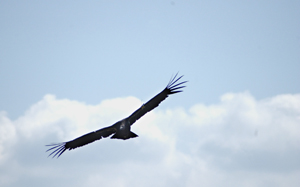Smaller caliber bullets banned by state Fish and Game
Commission
Less than two months after the state Legislature banned large
caliber lead bullets in condor habitat, the state Fish and Game
Comission approved new measures that will restrict lead .22 caliber
bullets and smaller rimfire from condor habitat.
Smaller caliber bullets banned by state Fish and Game Commission
Less than two months after the state Legislature banned large caliber lead bullets in condor habitat, the state Fish and Game Comission approved new measures that will restrict lead .22 caliber bullets and smaller rimfire from condor habitat.
“If we’re serious about recovery of the condor, we need to eliminate all sources of lead in the condor environment,” said Shawn Bagley, conservation advocate for the Center for Biological Diversity, an environmental group.
New restrictions from the California Fish and Game Commission, a state agency that is responsible for hunting and fishing regulations, went one step closer towards reaching that goal.
On July 1, 2008, hunters will no longer be able to use lead .22 caliber bullets and smaller lead ammo within condor range in Southern and Central California.
Lead poisoning has been a problem for California condors, who can ingest bullet fragments when they feed on carrion. At least 12 condor deaths in California have been caused by lead poisoning, according to a press release from Pinnacles National Monument staff. Many others are suspected, according to the press release from Pinnacles.
Two condors from Pinnacles National Monument were treated for lead poisoning at the Los Angeles Zoo last summer. One died during treatment.
The second was treated and released in Pinnacles National Monunment but was later found dead. The cause of death was inconclusive, but a history of lead poisoning might have been a complicating factor, said Jim Petterson, supervisory wildlife biologist for Pinnacles National Monument.
A bill signed into law in October outlawed large caliber lead bullets for certain hunting activities in condor range. It exempted .22 caliber bullets and smaller rimfire ammunition because nonlead alternatives do not exist. The commission extended the restriction to smaller calibers because it felt that more action was needed in order to protect condors, according to the press release from Pinnacles.
“Their action is going to spur a market for non-lead ammunition,” Bagley said.
Until non-lead alternatives become available, options include larger .224 caliber and .243 caliber non-lead bullets, according to the press release from Pinnacles.
It is unclear if the new regulations will be enough to eliminate lead from the condors’ diet, Petterson said. The effect will depend upon the level of compliance.
“I think hunters, ranchers, and other outdoorsmen have a long history of conservation,” Petterson said. “I’m hoping that they will do what is right for wildlife and humans.”
Staff from Pinnacles National Monument will conduct a public education program about the regulations.
“We will be having, in the next year, at least seven of the non-lead shooting events,” Petterson said.
Lead bullets can adversely impact human health, Petterson said. Recent evidence shows that when a bullet enters a carcass the fragments distribute throughout the carcass.
“The amount of lead that is in a lead fragment is many orders greater than the lead in lead paint on children’s toys,” Petterson said.
Staff from the Center for Biological Diversity would like to see a statewide ban against lead bullets.
Scientific studies have shown that large numbers of bald and golden eagles suffer from high blood levels of lead and also die from lead poisoning, according to the press release.
“It doesn’t take many lead filled carcasses to poison a bird,” Bagley said.










